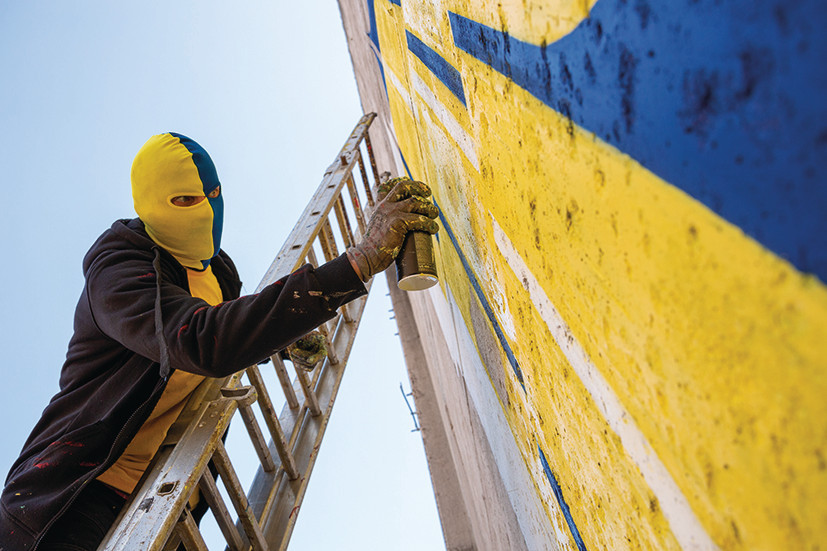One of the pioneers of graffiti as an art form in Luxembourg – alongside his good friends Sumo and Stick – Spike has spent the last 15 years or so focusing on projects in abandoned or soon to be demolished buildings and industrial sites in addition to creating commissioned pieces in public spaces (he is currently finishing a giant mural on the Corniche in that capital city for the Ville de Luxembourg).
Sites like the old airport terminal, the former Henri Funck brewery in Clausen or the Esch-Schifflange steelworks provided Spike with the sort of rough, industrial canvas in which his unique pieces, featuring variations on his trademark Spike shape, thrived.
Those private projects involved Spike scouting locations, sometimes that he had discovered himself, other times on a tip-off from friends, and then springing into action with his spray cans. He would document the pieces he created with the help of photographers like long-time collaborator Patti Neu and fellow friend Alain Craighero, or even Christian Aschman who initiated his Veil project in the former seed processing station in Mersch. Collected in beautifully designed books (see ) for each project, the photos were often the last testimony to the once vibrant and thriving sites and buildings that have now vanished from the landscape.
Group dynamic
But, as Spike explains, Ultras is “unlike anything I had done before.” The catalyst for the project was a viewing of the recent documentary by Asif Kapadia on Maradona and his time in Naples. “The transformation he brought to the city and the football club and the level of fanaticism he inspired was incredible,” he says.
I wanted to do a project that integrated the codes and the energy that distinguishes the group dynamic of the Ultras
And that reignited a certain nostalgia for the passion Spike had felt back in his teenage years when he stood with the Boys San Ultras in the Stadio Giuseppe Meazza in Milan supporting Internazionale. “I wanted to do a project that integrated the codes and the energy that distinguishes the group dynamic of the Ultras.”
That group dynamic also allowed Spike to call on friends to take part in the project. He created seven fictional Ultras clubs featuring seven colour combinations. He gave the clubs credible sounding names and went so far as to produce custom-made scarves and flags and bought smoke and flares to create an authentic atmosphere for the club photos.
Spike had also recognised that the world of Ultras shared undeniable parallels with that of graffiti writers and street gangs – a hypothesis borne out by further research into the distinct codes, clothes, rebellious attitude and group mentality of these youth subcultures. In the end, he put together a book, Ultras United, that complements the volume he has produced on the Ultras project itself.
“This is my way of illustrating everything that is positive about the Ultras. I love the whole organisation aspect, the visual effect and the power. But I clearly do not support the violence associated with the Ultras, nor the right-wing ideology,” he explains.
Ultras battles
The pieces Spike did for the Ultras project were divided into five Ultras battles, as he called them. He would produce seven pieces, one for each Ultras club, adhering to self-imposed distinctive characteristics in different spots in an isolated location, an electricity substation, on the extreme west of the Esch-Schifflange site he and Stick had used for their Schmelz project.
The results, as seen in the Ultras book of the double-volume that will go on sale next week, are stunning. Spike once again uses his chosen environment to great effect – pieces were painted on rough walls, on electricity transformers and circuit breakers, using the brutal architecture of monolithic pillars.
Now seeing the colours of the clothes I wore almost merge with the painted pieces, it is clear that I am at one with the club for each battle
Indeed, he worked in what was for him an unprecedentedly compact space as evidenced in some of the photos which show multiple layers of work.
In the end, although his fanatical football supporting days are behind him, Spike says he took pride in the project and even donned an outfit and a matching balaclava for each Ultras club. “Now seeing the colours of the clothes I wore almost merge with the painted pieces, it is clear that I am at one with the club for each battle.”
Ultras United – The Ultimate Battle an exhibition of seven photos from the project opens at Kulturschapp Walferdange (17, rue de la Gare) on Wednesday 16 November at 6pm. It is open Friday 18 November from 5 to 7.30pm and Saturday 19 and Sunday 20 November from 3 to 6.30pm.
The book is a double-edition released with seven different covers in the colours of the Ultras clubs created for the project. Each book contains a special set of 44 Panini-like stickers.


